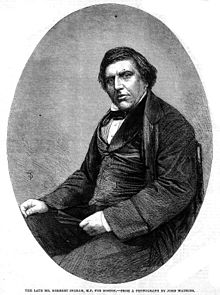Herbert Ingram
This article needs additional citations for verification. (January 2009) |
Herbert Ingram | |
|---|---|
 | |
| Personal details | |
| Born | 27 May 1811 |
| Died | 8 September 1860 (aged 49) |
Herbert Ingram (27 May 1811 – 8 September 1860) was a British journalist and politician. He is considered the father of pictorial journalism through his founding of The Illustrated London News, the first illustrated magazine.[1] He was a Liberal politician who favoured social reform and represented Boston for four years until his early death in the shipwreck of the Lady Elgin.
Early life
Ingram was born at Paddock Grove in Boston, Lincolnshire, the son of a butcher.[2] After being educated at Laughton's Charity School and the free school in Wormgate (a street in Boston), he was apprenticed as a 14-year-old to town printer Joseph Clarke. When Ingram finished his training, he moved to London, where he worked as a journeyman printer.
In 1832, Ingram established his own printing and newsagents business in Nottingham, in partnership with his brother-in-law, Nathaniel Cooke. As a newsagent, he noticed that when newspapers included woodcuts, their sales increased. He concluded that making a good profit would be possible from a magazine that included a large number of illustrations. However, a while was needed before he could put this theory into practice. The newsagent business failed to make much progress until Ingram purchased the rights to a laxative known as Parr's Life Pills. The profits from marketing these pills provided the capital that enabled him to set up and publish The Illustrated London News.
The Illustrated London News

Ingram moved back to London, and after discussing the matter with his friend, Mark Lemon, editor of Punch, he decided to start his own magazine, The Illustrated London News. The first edition appeared on 14 May 1842. Costing sixpence, the magazine had 16 pages and 32 woodcuts and targeted a broadly middle-class readership. It included pictures of the war in Afghanistan, a train crash in France, a steam boat explosion in Canada, and a fancy dress ball at Buckingham Palace. That pictorials were viewed as being as important as text for reporting was clear from the first issue, which stated that the aim was to bring within the public grasp "... the very form and presence of events as they transpire; and whatever the broad and palpable delineations of wood engraving can achieve, will now be brought to bear upon every subject which attracts the attention of mankind".
Ingram was a staunch Liberal who favoured social reform. He announced in The Illustrated London News that the concern of the magazine would be "with the English poor" and the "three essential elements of discussion with us will be the poor laws, the factory laws, and the working of the mining system". Despite arguing the case for social reform, the paper claimed to be nonpartisan. Its first editorial had stated, "We commence our political discourse by a disavowal of the unconquerable aversion to the name of Party." However, this may have been no more than a desire to gain the widest possible readership, because as time progressed, the paper displayed its
The magazine was an immediate success, and the first edition sold 26,000 copies. Within a few months, it was selling over 65,000 copies a week. High prices were charged for advertisements, and Ingram was soon making £12,000 a year from this publishing venture. Encouraged by the success of The Illustrated London News, Ingram decided in 1848 to start a daily newspaper, the London Telegraph. When Andrew Spottiswoode started a rival paper, the Pictorial Times, Ingram purchased it and merged it with the Illustrated London News. In 1855, Ingram took over another rival, the Illustrated Times.
Ingram employed leading artists of the day to illustrate social events, news stories, and towns and cities. The whole spectrum of Victorian Britain was recorded pictorially in The Illustrated London News for many decades; special events were important to its success. The magazine did very well during the
The Illustrated London News is still published today. Alison Booth, its current editor, said: "He was very inventive and far-sighted and his legacy of bringing pictures to journalism can still be seen on the front pages of newspapers and magazines all over the world. The Illustrated London News had many imitators, but none came close. His first edition featured a great fire in Hamburg, Germany, and drawings portrayed the horror for readers. The popularity of the paper soared and attracted the most talented artists."
MP for Boston

In 1856, Ingram became the Liberal candidate in a by-election in his home town of Boston. With help from his friends Mark Lemon and
He continued his campaign for social reform in the House of Commons until his death four years later.
Ingram was instrumental in bringing the Great Northern Railway to Boston, which forged new links with other parts of the country and got the town on track for a new era of growth. He also played a major part in supplying fresh piped water to the town, a move that was met with rejoicing and brass bands when the taps were turned on for the first time.
Death and legacy
In 1860, Ingram went to the US with his eldest son to obtain material for The Illustrated London News. On 8 September, they were aboard the
A statue of Ingram is in the Market Place in Boston in front of
References
- ^ "The History of Magazines". Magazines.com.
- doi:10.1093/ref:odnb/14416. (Subscription or UK public library membership required.), quoted on The Early History of The Illustrated London News
- ^ "'Waiting for the Waves to Give Up Their Dead,'". Chicago Tribune. 2 October 2020.
External links
- Hansard 1803–2005: contributions in Parliament by Herbert Ingram
- Herbert Ingram Archived 7 June 2010 at the Wayback Machine – Lincolnshire County Council
